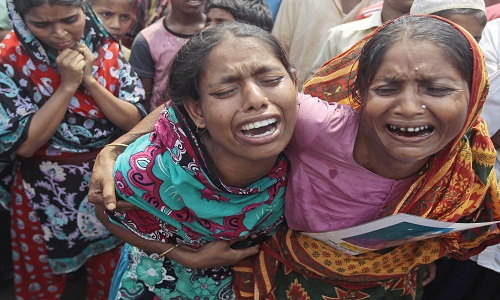FW
The Pakistan Readymade Garments Manufacturers' and Exporters' Association (PRGMEA) has sought early discharge of export relating statements made by the government in recent past. It has also sought a direct intervention from the prime minister in this regard.
PRGMEA leadership, including the Senior Vice Chairman Sohail A Sheikh and Chief Co-ordinator Ijaz A Khokhar, has demanded zero-rating regime announced by the Prime Minister forthwith and not from July 2016 besides issuance of bonds for the exporters as per the federal finance minister. PRGMEA says the government should honour commitment and restore exporters' confidence. The government had assured of releasing bonds within one week but nothing has happened despite lapsing a considerable period. A trust deficit has hampered the liaison between the government and business community, which is needs to be removed, suggested Khokhar.
PRGMEA’s senior vice chairman said no one from the government is serious about stopping freefall of exports amidst GSP Plus status from the EU. He urged the PM to intervene and take appropriate steps to save the export-oriented sectors. Apart from the sales tax refunds, billions of rupees under the textile policy initiatives like DLTL are still held up for which funds should be released immediately, added Sheikh.
The Zimbabwe Textile Manufacturers’ Association (ZTMA) has embarked on a survey to assess the performance of the sector while mobilising funds to help expand the industry. ZTMA vice chairman Freedom Dube recently said his organisation was conducting site tours of companies across the country following the end of the annual shut down. The site tours of members will access who has re-opened after the annual shutdown and also establish what’s happening in their operations.
Dube says, due to operational constraints like stiff competition from imports, liquidity challenges and obsolete plant machinery, local textile firms closed 2015 operating at around 34 per cent capacity utilization. In terms of funding, textile companies need a combined $20 million working capital and capitalization.
Among a host of measures, players in the clothing and textile sector want the government to consider extending the rebate on textiles by another year to allow recovery. At its peak the clothing sector employed over 40,000 people compared to about 8,000 as of last year.
The country’s textile and clothing sub-sectors consist of three components namely: production and ginning of cotton, transformation of lint into yarn and fabric, and the conversion of fabric and yarn into garments.
Exporters in Tirupur want additional specialty fabrics to be included under customs duty free import. Most specialty fabrics are synthetic. Among specialty fabrics are nylon, burlap, oil cloth, anti-tarnish silver cloth, silver polishing cloth, huck toweling, cheese cloth, heat resistant fabrics, mosquito netting, crib liners, cotton voile, organic cotton fabrics and organic bamboo fabrics.
These fabrics are used for a wide range of industrial and commercial applications. The end-uses for these fabrics include pool covers, hydraulic covers, aprons, golf bags and golf wear, cold weather garments, dust covers.
As the potential to increase readymade garment exports depended on the export of synthetic garments which have a market throughout the year globally, exporters say the additional inclusion of more specialty fabrics will be helpful in enhancing their growth and competitiveness and help them employ additional workers.
Already imports of specified fabrics (for manufacture of textile garments having an export value equivalent to one per cent of FOB value of exports in the preceding financial year) have been exempted from payment of basic customs duty. The industry wants some 20 items widely used by Tirupur knitwear garment exporters for manufacturing exportable value added garments to be included for exemption.
South Korea has developed a fabric that is superbug resistant by using pigment from bacteria. This anti-bacterial fabric was developed using a natural bacterial pigment called Violacein, a violet pigment naturally made by bacteria found in nature, and is reported to have antibacterial, antiviral, antiprotozoal and anticancer effects.
Violacein, an indole derivative, is a violet pigment made by naturally occurring bacteria such as those belonging to the genus chromobacterium. Violacein has been reported to have antimicrobial and antiparasital properties in microbiology literature.
The bacterial pigment was coated to the fabric. The coated fabrics inhibit the growth of super bugs by 99.9 per cent. The work could be first of its kind to effectively utilise bacterial pigment as a coating agent on fabrics to impart antimicrobial properties.
The Korean team has developed prototype face masks and they are currently being put to use in a local hospital. This widespread use of antibiotics has resulted in the ongoing and ever-increasing prevalence of antibiotic-resistant bacteria also known as superbugs. Every year lakhs of patients die from a drug-resistant superbug.
This is the first case where an antibacterial fabric was produced using violacein. This fabric has the possibility to reduce the impact of super-bacterial infections.
The home textile industry is giving importance to sustainability. Textile sustainability encompasses many factors including responsible chemical and natural resource use and respect for workers and communities. Textile sustainability also includes safe and environmentally effective production practices and products that are free from harmful levels of dangerous substances.
There is a comprehensive portfolio of testing and certification programs that help home textile companies attain all those standards. Science-based testing and certification can help defend and build brand equity in a risky global market place.
Consumers want to know that their products are made responsibly with respect for people and the environment. Consumers are demanding sustainability in their apparel and home textiles will not be far behind. There is a high level of consumer interest in and demand for sustainable products.
People also want to know that the products they buy are safe for their families to use and in order for manufacturers to meet those demands they have to know every detail about the production process. Third party testing and certification can take away much of the uncertainty inherent in a complex supply chain and help ensure that products and facilities live up to expected standards.
The textile yarn market is projected to grow at a CAGR of 4.2 per cent from 2015 to 2020 and reach $12.64 billion dollars by 2020. The market growth is driven by higher levels of discretionary expenditure by consumers and development of new varieties. The market is further driven by factors such as urbanisation and high industrial requirement.
Asia-Pacific accounts for the largest market share for textile yarn, followed by North America and the rest of the world. Textile yarn products such as cotton and polyester are among the widely used products in Asia-Pacific; changing consumption pattern is one of the major factors driving the textile yarn market in this region.
The North American region is projected to be the fastest growing market with investments from several multinational manufacturers, especially in countries such as the US and Canada. Stringent government regulations for the trade of textile yarn products pose one of the inhibitors for the textile yarn market. Also, the volatility in production level of plant and animal source yarn hinders the growth of the textile yarn market.
With 47 million spindles and 0.75 million open-end rotors, India has the world’s second largest spinning capacity. Cotton yarn accounts for nearly 73 per cent of total spun yarn production.
"More than trends and new designs, clothes have gotten much cheaper with the rise of ‘fast fashion.’ Today, anyone can chase trends, even on a budget. The ability to buy low-cost clothing is not necessarily a good thing. Here are three reasons why $14 jeans and $25 dresses cost more than one thinks."

The craze for cheap clothes puts a strain on our environment. Moreover, there are several aspects involved in cheap clothes which one may not be aware of. Indeed, the fashion world is changing rapidly. Neon colors, power suits with shoulder pads, and fingerless gloves witnessed in the 80s are forgotten now. The 90s featured Doc Marten boots, butterfly hair clips and babydoll dresses. The early 2000s brought us low-rise pants, blazers, and the first incarnation of the skinny jeans phenomenon.

More than trends and new designs, clothes have gotten much cheaper with the rise of ‘fast fashion.’ Today, anyone can chase trends, even on a budget. The ability to buy low-cost clothing is not necessarily a good thing. Here are three reasons why $14 jeans and $25 dresses cost more than one thinks.
Tragic human aspects
The requirement of incredible manufacturing output made international brands like H&M, Zara, and Gap make arrangements for required stocks. To meet that need, it's much cheaper for clothing retailers to have their garments manufactured overseas. Currently only 2 per cent of clothing for sale in America is made domestically. Manufacturing goods overseas is an exercise of good economics. If factories in Bangladesh or China can make clothes for less than factories in America, it makes sense for companies to use them. However, unsafe and unethical labor practices are major reason for the cheapness of foreign manufacturing.
Even with regular improvements, there has not been sufficient supply chain management to ensure overseas garment workers are not exploited or working in unsafe conditions. The April 2013 Rana Plaza building collapse in Dhaka, which killed over 1,000 people, was partially attributed to the pressure placed on factories housed in the building to complete garment orders on time. Though Rana Plaza had been evacuated the day before the collapse when alarming cracks had appeared in the building, managers ordered factory workers to return to work the next day or lose a month's pay - with tragic results.
Incidentally, the fashion industry came together to improve safety for garment workers in Bangladesh but such an Accord will not do nearly as much as changes in consumer behavior will.
Environmental aspects
Strain on our environment is the other consequence of cheap clothes. Even though cotton and wool are renewable resources, they are finite. Polyester is already the world's dominant clothing textile and that trend can only continue while we treat clothing as disposable. It may seem as though there is an easy way to have fast fashion and ease environmental guilt too - just donate cast offs to charity.
According to a Salvation Army distribution center in New York City, the center processes an average of five tons of garments every day and only chooses 11,200 (pieces) to send out to stores.
Low cost, standard factor
The money made from fast fashion is through rapid turnover. For eg, H&M has new garments coming into the stores almost every day. Once a look premieres on the runway, a fast fashion manufacturer like H&M or Zara can design and produce a knockoff and have it on display in stores worldwide within a few weeks. This situation may be great for fashionista on a budget, but it's tough on the high-end clothing designers and fashion houses.
If high-end manufacturers like Ralph Lauren or Tommy Hilfiger have to speed up their process, generally, there is a six month lag-time between a garment's appearance on the runway and its availability for purchase - it is inevitable that they will have to lower their standards in order to do so.
This affects regular consumers when it becomes impossible to find a dress or slacks that can be hemmed or altered without being destroyed. When all of the ubiquitous clothing choices are disposable, even the high-end ones, then the clothing line in your budget gets bigger, even if individual items are cheap to buy.
Best clothing choices
Clothing is not optional unless you live and work in a remarkably open-minded area. There are several ways to make great clothing choices that don't overload your budget or your conscience. For example, wear what you buy. It is important to invest in high quality clothing because; money spent on high quality clothing can be a better investment. Swapping clothes with friends is another option. A great way to handle issues of changing tastes - is to regularly hold clothing swaps with friends.
Even if your cheap clothing purchases don't hurt your budget in the short term, the long-term costs of fast fashion can be far too expensive. So avoid over spending on cheap clothes.
Japan is signing a free trade agreement with the EU. The EU and Japan are keeping leading roles in the development of advanced technological materials and creating high quality fashion goods. For the EU’s textile and clothing sector, Japan is among the top 10 largest customers. For the Japanese industry, the EU is the second biggest export market. The EU mainly exports clothing and in particular premium products made from wool and silk while it imports fibers and yarns from Japan.
Japanese and European textile and fashion sectors face similar challenges. The free trade agreement will help their companies increase trade and investment potential. A comprehensive trade deal will build platforms for R&D cooperation creating innovation and business opportunities.
Full elimination of tariffs, which will mean duty free access from day one for all textile and clothing products, will be beneficial for industries on both sides. Currently, tariffs are quite similar in both parties; duties can be up to 11 per cent when exporting clothing to Japan.
The trade deal shall result in simplification of burdensome customs procedures. Japan with its progressive technologies is already one of the EU’s most advanced partners. The trade deal will have a positive impact not only on the flow of goods between the countries, but also enhance the spillover effect in innovation.
January cotton crop in India for the 2015-16 season has been estimated at 353 lakh bales, whereas in December, the estimate was 357 lakh bales. Total cotton supply for the 2015-16 season has been estimated at 440.60 lakh bales while domestic consumption is estimated at 315 lakh bales, thus leaving an available surplus of 125.60 lakh bales. The arrival of cotton during the ongoing 2015-16 crop year is estimated to be lower than last year up to the same period.
This is due to the fact that farmers are holding back seed cotton expecting better prices. Arrivals are lower this year also due to the relatively lower crop estimated for the 2015-16 crop year compared to last year. The cotton crop estimate for Punjab is nine lakh bales this year while in Haryana it is 17 lakh bales. Last year, Punjab yielded an estimated 13 lakh bales while Haryana yielded 23.50 lakh bales.
There are four major cotton species of cultivated cotton and India is the only country to grow all four species of cultivated cotton. In addition, hybrid cotton is also cultivated in the central and southern zones. The diploid species contributes 25 to 30 per cent of the country’s production. The tetraploids variety contributes the remaining 70 per cent of the cotton production in India. These varieties have fine quality fiber and are normally used by the textile industry.
Leading global technology research and advisory company Technavio’s latest report on the global textile machinery market provides an analysis on the most important trends expected to impact the market outlook from 2016 - 2020. Technavio defines an emerging trend as a factor that has the potential to significantly impact the market and contribute to its growth or decline.
According to Technavio heavy industry research analysts, the top three emerging trends driving the global textile machinery market are: Automation in textile machinery, growing popularity of spinning machinery in India and overseas demand for Spanish machinery.
According to the report, automation plays a crucial role in improving the quality and cost-competitiveness of textiles. Automated textile machinery accelerates textile production and increases the flow rate of fabric, enabling lean manufacturing.
Technavio expects spinning capacity in India to develop, as the country has high cotton export demand. More than 10 -15 per cent capacity will likely be added in the next year. This creates a positive scenario for the domestic spinning machinery manufacturing industry.
The report says that the Spanish textile machinery manufacturers are gradually making a mark in the global market as they develop the latest technologies in areas such as braiding, technical fabric, spinning, finishing, dyeing, and printing. These manufacturers also manufacture customized machines and are also exporting over 80 per cent of their production.












